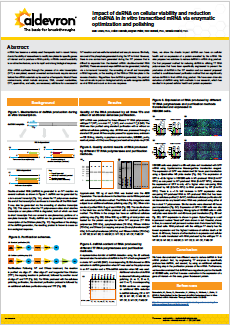
Optimize mRNA Production From the Very Start With Quality Starting Materials
Download Poster
| region | na1 |
| portalId | 1769030 |
| formId | 11bdc374-6e4d-4573-9c3e-6729f05df0bc |
| target | services-hubspot-form |
| redirectUrl | https://www.aldevron.com/thank-you/poster-dsrna-optimize-synthesis |

Impact and Reduction of dsRNA to Optimize Synthesis
The road from research to final drug product requires a broad set of skilled experts and high-quality materials. At Aldevron, we provide proper support from the very first step – the critical raw material for RNA manufacturing for research and clinical applications.
The in vitro transcription (IVT) process generates unwanted contaminants that must be removed before the mRNA can be used as a therapeutic. Most of these contaminants are well-characterized and easy to remove. However, double-stranded RNA (dsRNA) is difficult to separate from the desired mRNA. Contaminating dsRNA has a dramatic impact on biological activity as cells recognize dsRNA as viral RNA and mount an immune response.
Our poster, “Impact of dsRNA on cellular viability and reduction of dsRNA in in vitro transcribed mRNA via enzymatic optimization and polishing”, shows the drastic effect dsRNA can have on cellular health and protein expression. We propose two solutions to reduce dsRNA. The first option is a cellulose-based purification method that can significantly reduce dsRNA in final mRNA drug substance. The second method uses an engineered T7 RNA polymerase, like our Codex® HiCap T7 RNA Polymerase, which significantly decreases the generation of dsRNA.
We have seen dramatic reduction of dsRNA using both methods in our research and manufacturing process, which has resulted in improved cellular health and protein expression.